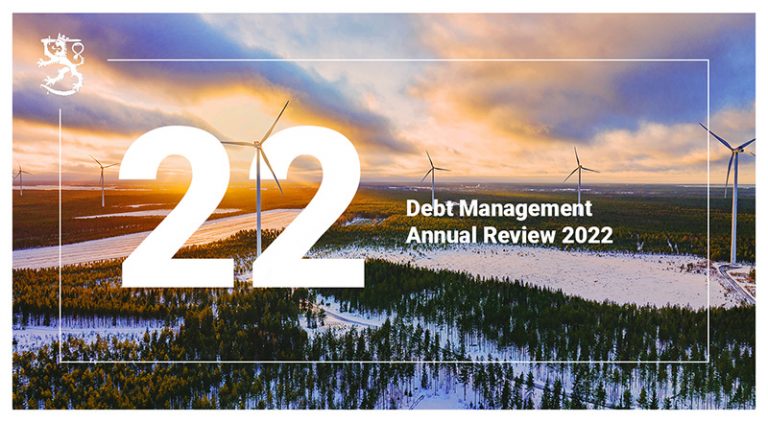
Investor demand for Finnish government bonds remained solid despite a historically high level of sovereign bond supply in eurozone, and central banks’ quantitative tightening.
In 2023, the Republic of Finland successfully carried out an issuance programme totaling EUR 42.3 billion. Net borrowing amounted to EUR 14.2 billion.
At the end of 2023, Finland’s central government debt totaled EUR 156.2 billion, or 55.4% of GDP (52.7% in 2022). General government debt in relation to GDP totaled 75.5% (73.3% in 2022).
Year 2023 was two-folded. At the beginning of the year, inflation remained high and interest rates were under upward pressure. By the autumn, however, rapid slowdown in inflation accelerated expectations of central banks’ monetary policy easing causing a turnaround in market interest rates.
“Last year, the borrowing requirements throughout the eurozone were at historically high levels, but from an investor’s point of view, the attractive yields made this supply easier to digest. This was particularly evident at the end of the year and at the beginning of this year as we witnessed large oversubscriptions in all euro-area emissions, including our own”, says Teppo Koivisto, Director of Finance at the State Treasury.
In addition to elevated borrowing needs, the quantitative tightening of central banks can be viewed as additional net supply that has to be met with new investor demand. According to Koivisto, this has not changed the investor demand or allocations of Finnish government bonds.
“Our starting point has always been that the non-standard bond-buying programmes were temporary in nature. We carry our debt management over the long term, and focus on fostering a long-term investor base”, Koivisto emphasises.
NATO membership bolsters credit outlook
Finland’s accession into NATO was one of the key events of 2023. By joining the alliance, Finland sent a strong message also to financial markets. Finland’s membership not only strengthens the country’s international position and NATO itself; but according to Koivisto, it also speaks volumes about Finland’s foreign policy abilities. When the geopolitical environment changed, Finland moved quickly.
Sovereign bond investors have been intrigued by Finland’s foreign and security policy decisions. For this reason, the Debt Management Annual Review includes an article by Dr. Iro Särkkä from the Finnish Institute of International Affairs on Finland’s future direction in NATO. However, investors are also keen to know how the defence expenditure under NATO will affect Finland’s public finances over the long term.
“The bottom line is that Finland has always maintained its own defence capabilities. That is why meeting the NATO guideline of 2% of GDP in defence spending does not require from us such a budget uplift as in many other countries”, Koivisto notes. Furthermore, he estimates that NATO membership will also benefit the country in the form of increased economic cooperation.
Two other topical themes covered in the Debt Management Annual Review are biodiversity and green transition. Professor of Biodiversity Research Ilari E. Sääksjärvi gives his account on where Finland stands in terms of its EU and national level obligations of halting the loss of biodiversity. Janne Peljo, Chief Policy Adviser at the Confederation of Finnish Industries, explains why Finland is well positioned for green investments, citing the €220 billion euros worth of investment plans currently in the pipeline.
Debt sustainability taken seriously
Finland’s central government deficits have increased to a higher-than-usual level. According to the General Government Fiscal Plan, which extends to 2027, Finland’s annual gross borrowing needs will remain at EUR 40–45 billion, and its net borrowing at more than EUR 10 billion. On a positive note, Teppo Koivisto highlights the Government Programme and its ambitious goals for strengthening general government finances.
“The Finnish government has not shied away from addressing the issues of debt sustainability. This is a strong signal, as it indicates that we are well aware of the need to stabilise our debt ratio,” emphasises Koivisto.
In 2024, the Republic of Finland’s gross borrowing requirement is EUR 43 billion. Roughtly 8% of this borrowing has already been completed. Finland’s credit outlook remains stable and its funding plans are clear, which, according to Koivisto, provides a good basis for issuing bonds.
“We know exactly what we’re doing.”
The Debt Management Annual Review 2023 summarises the borrowing, liquidity management, and risk management activities of the State Treasury Finland. Read the review: treasuryfinland.fi/annualreview2023
Further information: Teppo Koivisto, Director of Finance, tel. +358 295 50 2552, teppo.koivisto@statetreasury.fi
Government borrowing and debt management 2023 in numbers (2022):
- Gross borrowing: EUR 42.3 billion (EUR 34.3 billion)
- Net borrowing: EUR 14.2 billion (EUR 12.7 billion)
- Emissions: 79 (41)
- Average yield on 10-year RFGB benchmark bond: 3.06% (1.69%)
- Effective cost of central government debt at the end of the year: 2.12% (1.06%)
- Average fixing of central government debt: 4.4 years (4.4 years)
- Average maturity of central government debt: 7.38 years (7.61 years)
- Interest expenses of central government debt: EUR 2.3 billion (EUR 0.8 billion)


